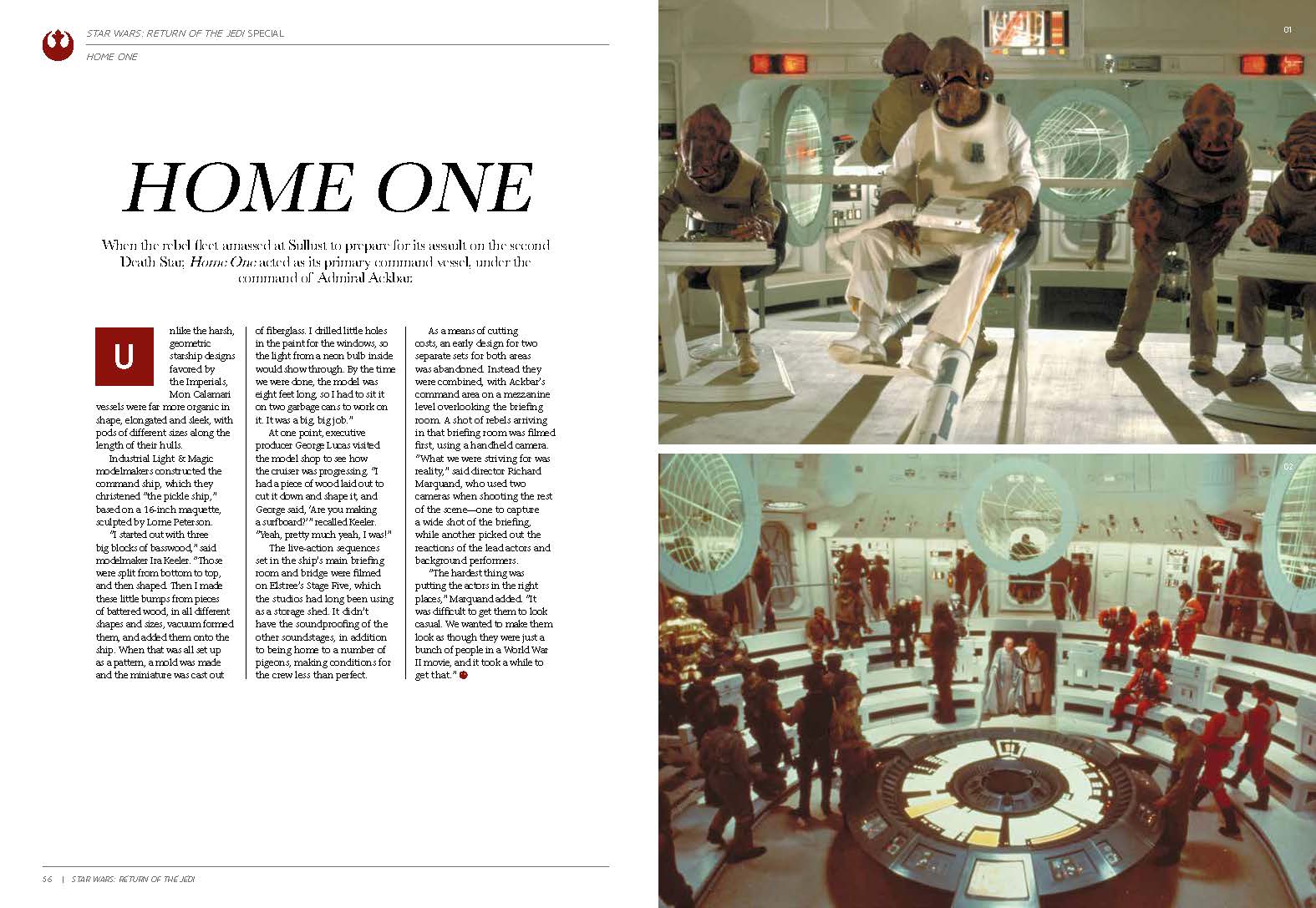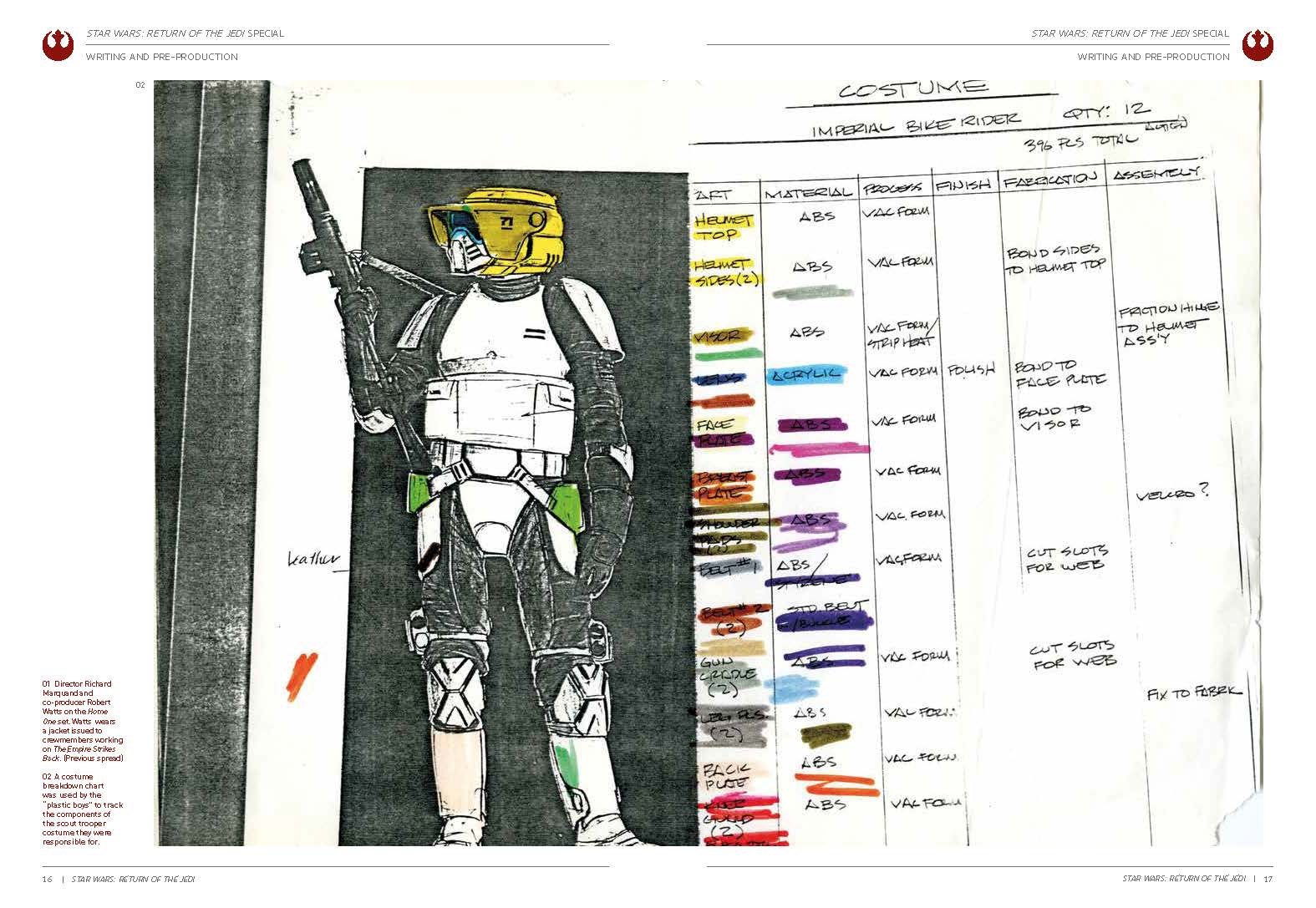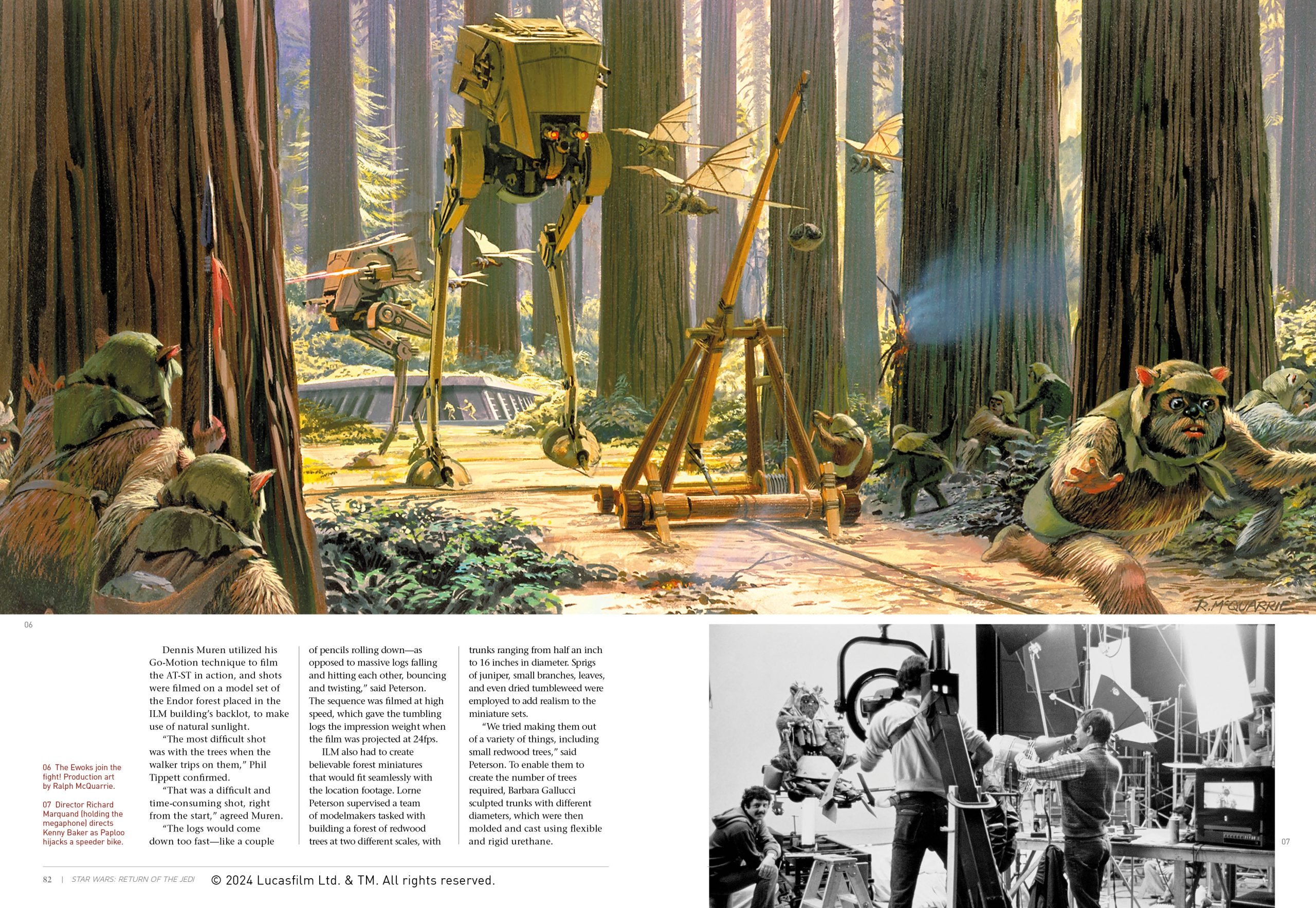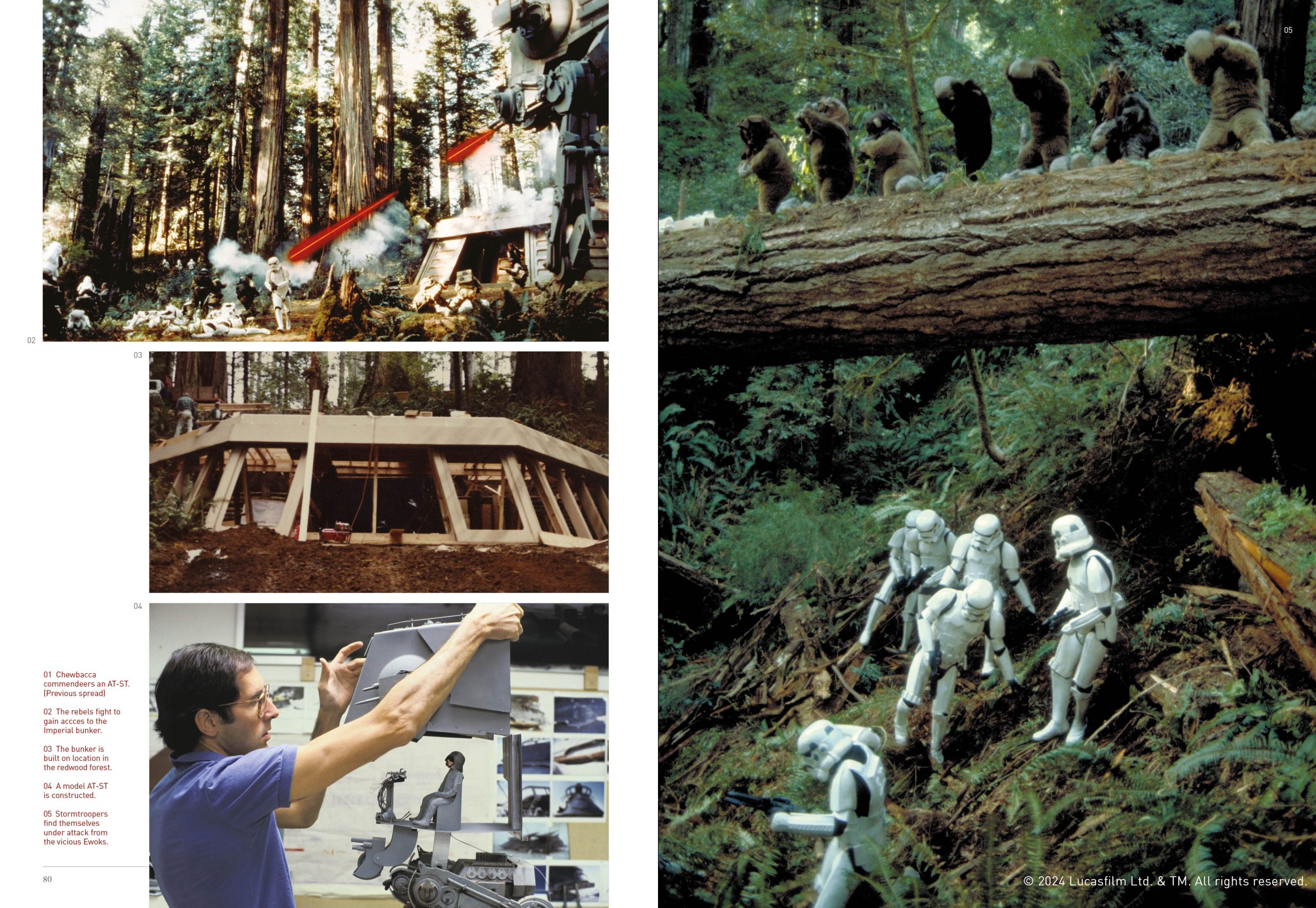In 1983 George Lucas and an amazing team at Lucasfilm and ILM brought the original trilogy to a close in the exhilarating and emotional Return of the Jedi. With fans still enjoying and celebrating the film 40 years on this special edition book from Titan Books takes us into the challenging and often gruelling process that brought the movie to the screen as the teams pushed boundaries to not only extend the story of a galaxy far, far away but also to push the emerging filmmaking technologies that had been developed for the first two instalments of the trilogy.
Take a look at some of the features you can expect to see in the comprehensive guide, which hits shelves on May 7th.

Writing and Pre-Production on Return of the Jedi
This title should really be the other way around as, with his focus on design and production, George Lucas had his design department launch ahead with concepts for Jabba, the speeder chase, Ewoks, and more — long before there was even a first draft of the script. The success of Star Wars owes so much to its visual language and that was achieved by George giving Joe Johnston, Ralph McQuarrie, and the rest of his design department free reign to develop their ideas, checking in with them regularly and marking the ideas he approved of with his coveted red marker dot.
As with the other Star Wars films, the story of how they came to be can be as much a battle against long odds as the movies themselves and just as fascinating to learn about. Return of the Jedi is no exception and the Collection details how George battled with a 24/7 writing schedule before Lawrence Kasdan agreed to jump back aboard the “speeding train” as screenwriter, while the script was worked around Han Solo’s presence or absence as, at the time, George was unsure if Harrison Ford would be willing to return for the movie. These early details only make me more grateful for the pure joy that Jedi continues to bring 40 years later.
The Court of Jabba the Hutt and Its Influence on Return of the Jedi
‘Without question, the hardest scene in every way, was Jabba’s Palace”, declared director Richard Marquand. Incredibly hot, and incredibly crowded on a set built for puppeteers operating creatures from above and below as well as performers in complex makeup moving around the floor. Read about the harsh conditions and also the dangers of being on the set, where Mark Hamill had to pull double duty preventing actress Femi Taylor, who played dancer Oola, from being choked by her chain by Jabba’s operators who had little visibility. Even C-3PO, programmed for etiquette not destruction, managed to injure a crewmember during the shoot! More of the hazards and hardships are detailed in the full article, but a philosophical Anthony Daniels sums it up in closing.
“It looked good on screen, and that’s what counts in the end”
More features delve into the creation of Jabba, who required a real team effort to bring him to life with performers pulling 10-hour shifts operating different parts of the body to bring him to life, and the Rancor who went through a complete rehaul after George’s original vision for a performer wearing a 15-foot suit didn’t pan out.
Into the Sarlaac Pit
While Tatooine scenes for A New Hope were filmed in Tunisia, the delightfully-sounding “Buttercup Valley” in Yuma, Arizona, provided the sand-filled environment required for Jabba’s failed execution attempt. Read how the massive set was built from wood, with crew offices, storage and even catering built into the framework and hidden below the desert sand. As well as the massive barge two skiffs were built, well worth the expense according to Marquand as it allowed one skiff to be close to the ground, making it safe for stunts while the other was higher up and rigged to tilt as it was hit by cannon fire from the barge.
The Emperor In Return of the Jedi
While we know Sheev Palpatine’s backstory as told across the three movies of the prequel trilogy, you can dig into the origins of his creation behind the scenes in this feature which tells the story of how young theatre performer Ian McDiarmid was brought in to replace 75-year old Alan Webb, who had to pull out due to illness. The casting director had seen Ian play a much older character on stage and suggested him for the part and he was quickly cast for the role.
Having a young actor in the role was a surprise to many, not least Mark Hamill, who had invited him over to dinner after realizing he had no idea what his co-star looked like under the makeup! The makeup had a huge influence on McDiarmid who admits to spending hours just staring at himself in the mirror! Although initially instructed to emulate Clive Revill’s performance in The Empire Strikes Back, McDiarmid talks about how looking at the face gave him the idea for the now-iconic Emperor’s voice. Another anecdote shared by the actor talks about how he invited children of friends to see the film and they were too terrified to speak to him afterwards!

Home One
In the excerpt above, read how the model for the Rebel “pickle ship” (which recently returned in all its glory as the New Republic flagship in Ahsoka) was carefully crafted from a wooden frame so big that had George Lucas joking that the modelmaker was building himself a surfboard! The tiny film stage (normally used for storage and home to a flock of pigeons) used for filming necessitated the mezzanine design of the set, which was originally intended to be filmed on two sets – another example of filming constraints leading to innovation and a now iconic scene.

Endor
A number of features open up how the world of Endor and its inhabitants were made for the screen. A privately-owned section of redwood forest in Northern California was transformed into the Empire’s hidden base with a fully assembled bunker, AT-ST and sections of Ewok village, with the rest of the scenes filmed at Elstree Studios in England.
Perhaps one of the biggest sequences in the movie is the speeder bike chase, where Luke and Leia race after the new addition to the Stormtrooper family – the Scout Trooper. No source was untapped to make the new faceplate, not even the kitchen sink – a piece from a faucet was used as part of the breathing apparatus! Denis Muren and Ken Ralston previsualized the sequence using Kenner action figures as stand-ins for the characters. What I found fascinating was how innovative stop-motion techniques were used to film most of the sequence with Mark Hamill and Carrie Fisher filming their closeups on a blue screen. To build the illusion of a high speed, Garret Brown, the inventor of the Steadicam was brought in to record footage of the forest which was then sped up and used as background plates for the finished shot.

Of course, it wouldn’t be Endor without the Ewoks. George Lucas had a vision of a primitive society overthrowing the technological might of the Empire. In his original outlines the Wookiees were going to be the primitive species but Chewbacca had shown himself to be very technically proficient in The Empire Strikes Back so George had a simple solution – “I’ll make them short Wookiees”.
The feature details the back-and-forth process until the final product of an army of adorable teddy bears that the Empire, the Rebels (and the audience) failed to see as a true threat, further bringing the original point across (Check out the exclusive spread below provided to us by Titan Magazines). A call was put out for actors of the right stature to fill the suits. Actor and Star Wars veteran Warwick Davis answered it. He claims it was purely his enthusiasm for Star Wars that landed him the lead part of Wicket.

The Fight on the Forest Moon
The climactic final battle of the original trilogy took place in three parts, with the first being on the ground between a legion of the Emperor’s best troops and a small band of Rebel saboteurs aided by teddy bears with sticks – glorious! Reading about the process it’s clear that filming the battle was as chaotic as fighting it, due to the nature of filming in dense forest, as attested to by director Richard Marquand.
“You’d say to the Ewok extras ‘Run, disappear, hide!’ But then you’d find that they were lost; you don’t know where they’ve gone…”
The technical details of the shoot are fascinating too. Multiple AT-STs were built at different scales and from different materials so they could be knocked over and smashed by the Ewoks. The combination of miniatures and full-scale pieces work so well when put together and it’s well worth reading about all the work that went into the separate components that went together to build the culmination of George Lucas’ vision (Check out the exclusive spread below provided to us by Titan Magazines). Another highly technical sequence is the detonation of the shield generator, which was carefully planned and all captured on-camera in a single take.

There are many other fun details but one that jumped out to me was that Ben Burtt, sound designer for the original and prequel trilogies, was cast as the Imperial officer that Han knocks over a railing. Ben is known for sneaking the “Wilhelm scream” sound effect into Star Wars movies and managed to insert it again here by performing it himself!
The Battle of Endor
While the ground battle required innovation in practical effects, the conflict in space pushed the VFX team to their limits as the wizards at ILM were pushed to achieve a bigger and better space battle than the iconic trench run of A New Hope. Shots compiled together could involve as many as 57 different elements, each on a separate piece of film for a shot that might only last a few seconds, with teams running day and night to compile the elements together. More insights into the process highlight the new technologies developed as well as the more low-tech solutions used by ILM to build the Death Star model, including six miles worth of cardboard tubes!
Of course, it’s not just the spaceships that make a great space battle, it’s the human performers that give weight and purpose to the action. The feature peels back the curtain on the performances given by Billy Dee Williams and the other actors who sat in cramped cockpit sets in front of a bank of cameras and lights to read their lines.
Another performer who had his work cut out was Tim Rose, originally brought in to operate Salacious Crumb, who played Admiral Ackbar – who was originally meant to be a “pale blue” alien (did we miss out on good-guy Grand Admiral Thrawn?) until the director fell in love with the squid-head design. Tim talks about how his experience working on The Muppets gave him the knowledge to inform George about how to give the character expression, contributing to his lasting popularity among fans.
Another fun fact is how actor Dermot Crowley, who plays General Madine, had to alter the appearance of his character because Kenner had already produced the action figure and his features didn’t match!
The Final Duel of Return of the Jedi
The third component of the battle is the very personal duel between Luke and his father, which was choreographed down to each step to create a flawless and emotional conflict where the producers used every asset to highlight the temptation that Luke was facing and the triumph of his victory. Read about how the final victory over the Emperor was achieved in a very practical way by Dave Prowse, who achieved the stunt despite being on crutches due to a knee injury.
Even more features uncover stories behind the post-production process and how scenes from the film were altered for the Special Editions and later editions as well as looking at the global lasting impact of Return of the Jedi. All these amazing insights into such a special movie are accompanied by large spreads featuring movie stills, behind-the-scenes images, and concept art throughout.
Star Wars: Return of the Jedi 40th Anniversary Collection is available to pre-order now and will release worldwide on May 7th. Order your copy below
Amazon
Forbidden Planet
Barnes & Noble
Books-a-Million

A teacher from Wales in the UK, Aled has loved Star Wars ever since that Star Destroyer flew over his head and blew his mind.
source: www.starwarsnewsnet.com